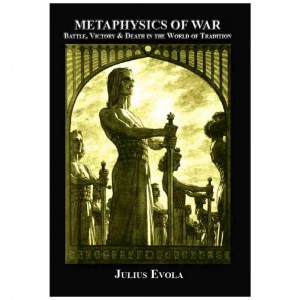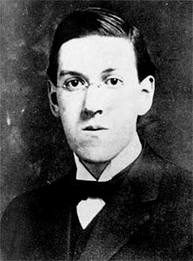One of the most serious obstacles to a purely biological formulation of the doctrine of race is the fact that cross-breeding and contamination of the blood are not the only cause of the decline and decay of races. Races may equally degenerate and come to their end because of a process – so to speak – of inner extinction, without the participation of external factors. In purely biological terms this may correspond to those enigmatic ‘inner variations’ (idiovariations) which science has been forced to recognize are just as powerful as variations due to cross-breeding in bringing about mutations.
This will never be completely understood if the biological conception of race is not integrated with that ‘racism of the second and of the third degree’ of which we have repeatedly spoken here. It is only if race is considered as existing not only in the body, but also in the soul and in the spirit, as a deep, meta-biological force which conditions both the physical and the psychical structures in the organic totality of the human entity – it is only if this eminently traditional point of view is assumed – that the mystery of the decline of races can be fathomed in all its aspects. One can then realize that, in a way analogous to the individual abdication and inner breakdown of the individual, where the loss of all moral tension and the attitude of passive abandonment can gradually find expression in a true physical collapse, or can paralyze natural organic resources far more efficiently than any threat to the body – so developments of the same nature can occur on the plane of those greater entities which are human races, on the greater scale in space and in time of their aggregate life spans. And what we have just pointed out about organic resources neutralized, when the inner – moral and spiritual – tension of an individual is lacking, can even allow us to consider less simplistically and less materialistically the matter of racial alterations due to mixing and contamination, as well.
This is quite similar to what happens in infections. It is known, in fact, that bacteria and microbes are not always the sole effective and unilateral causes of illness: for a disease to be acquired by contagion a certain more or less strong predisposition is necessary. The state of integrity or tonicity of the organism, in turn, conditions this predisposition, and this is greatly affected by the spiritual factor, the presence of the whole being to himself, and his state of inner intrepidity or anguish. In accordance to this analogy, we may believe that, for cross-breeding to have a really, fatally, inexorably degenerative outcome for a race, it is necessary without exception that this race already be damaged inwardly to a certain extent, and that the tension of its original will be lax as a result.
When a race has been reduced to a mere ensemble of atavistic automatisms, which have become the sole surviving vestiges of what once it was, then a collision, a lesion, a simple action from outside, is enough to make it fall, to disfigure it and to denature it. In such a case, it does not behave like an elastic body, ready to react and to resume its original shape after the collision (provided, that is, that the latter does not exceed certain limits and does not produce permanent actual damage), but, rather, it behaves like a rigid, inelastic body, which passively endures the imprint of external action.
On the basis of these considerations two practical tasks of racism can be distinguished. The first task could be said to be one of passive defense. This means sheltering the race from all external actions (crossings, unsuitable forms of life and culture, etc.) which could present the danger to it of a crisis, a mutation or a denaturation. The second task by contrast is that of active resistance, and consists in reducing to a minimum the predisposition of the race to degeneration, that is to say, the ground on which it can be exposed passively to external action. This means, essentially, ‘to exalt’ its inner race; to see to it that its intimate tension is never lacking; that, as counterpart of its physical integrity, within it there is something like an uncontrollable and irreducible fire, always yearning for new material to feed its blaze, in the form of new obstacles, which defy it and force it to reassert itself.
This second task is obviously more arduous than the first, because it can demand solutions which vary from individual to individual, and because external, general and material measures are of little use for it. It is a matter of overcoming the inertia of spirit, that force of gravity which is in force in human interiority no less than in the outer, physical world, and here finds expression precisely in the inclination to abandonment, to ‘take it easy’, to always follow the path of least resistance. But, unfortunately, for the individual as well as for the race, to overcome this danger it is necessary to have a support – for the ability to act directly, to always remain at the crest of the wave, to maintain an inner initiative which is always renewed, without the need for renewed stimuli, can only occur as the result of an exceptional endowment, and cannot reasonably be demanded as a matter of course. As we have said, for tension which has become latent to reawaken, before it is too late and the processes of the automatization of race follow, an obstacle, a test, almost a challenge, is necessary. It is then that the crisis and the decision occur: by their way of reacting, the deeper, meta-biological powers of the race then show whether they have remained stronger than the contingencies and the destinies of the given period of history. In the case of a positive reaction, new potentialities come, from deep inside, to saturate again the racial circuit. A new ascending cycle begins for that race.
In some cases, it is even possible that precisely cross-breeding – naturally kept within very stringent limits – carries out a function of that kind. This is well-known in zootechnics. The ‘pure breed’ in some animal species is the result both of the preservation of heredity and of judicious cross-breeding. We do not share the opinion of Chamberlain,[1] who was inclined to apply this kind of thinking to the ‘superior races’ of humanity. However, it is a well proven fact that in some aristocratic families, which, with their centuries-old blood law, have been the only experimental field for racism in history hitherto, some cross-breedings have had precisely the merit of preventing extinction of the line through inner degeneration. Here – let us stress – the cross-breeding has the function of an ordeal, not a rule – an ordeal, moreover, which can also present a dangerous challenge for the blood. But danger reawakens the spirit. Before the heterogeneous element introduced by cross-breeding the homogenous nucleus is called to reaffirm itself, to assimilate to himself what is alien, to act towards it in the capacity of the ‘dominant’ towards the ‘recessive’, in terms of the laws of Mendel.[2] If the reaction is positive, the result is an awakening. The stock which seemed spent and exhausted reawakens. But if it has already fallen too much, or if the heterogeneity is excessive, the ordeal is failed and the decline is quick and definitive.
But the highest instrument of inner awakening of race is combat, and war is its highest expression. That pacifism and humanitarianism are phenomena closely linked to internationalism, democracy, cosmopolitanism and liberalism is perfectly logical – the same anti-racial instinct present in some, is reflected and confirmed in the others. The will towards sub-racial leveling inborn in internationalism finds its ally in pacifist humanitarianism, which has the function of preventing the heroic test from disrupting the game by galvanizing the surviving forces of any still not completely deracinated peoples. It is odd, however, and illustrates the errors to which a unilaterally biological formulation of the racial problem can lead, that the racial theory of ‘mis-selections’, as expressed for example by Vacher de Lapouge, partakes, to a certain extent, of the same incomprehension of the positive meaning of war for race – but here, in the face of full knowledge of the facts – as is found in internationalist democratism. To be specific, they suppose that every war turns into a progressive elimination of the best, of the exponents of the still pure race of the various peoples, facilitating thus an involution.
This is a partial view, because it only considers what is lost through the disappearance of some individuals, not what is aroused to a much greater extent in others by the experience of war, which otherwise would never have been aroused. This becomes even more obvious if we do not consider ancient wars which were largely fought by elites while the lower strata were spared by them, but rather modern wars which engage entire armed nations and which, moreover, in their character of totality, involve not only physical but also moral and spiritual forces of combatants and non-combatants alike. The Jew Ludwig[3] expressed fury about an article published in a German military review, which brought out the possibilities of selection related even to air bombardments, in which the test of sang-froid, the immediate, lucid reaction of instinct of direction as against brutal or confused impulse, cannot but turn out in a decisive discrimination for those who have the greatest probability of escaping and surviving.
The indignation of the humanitarian Jew Ludwig, who has notwithstanding become the bellicose propagator of the ‘new Holy Alliance’ against Fascism, is powerless against what is correct in considerations of this sort. If the next world war is a ‘total war’ it will mean also a ‘total test’ of the surviving racial forces of the modern world. Without doubt, some will collapse, whereas others will awake and rise. Nameless catastrophes could even be the hard but necessary price of heroic peaks and new liberations of primordial forces dulled through grey centuries. But such is the fatal condition for the creation of any new world – and it is a new world that we seek for the future.
What we have said here must be considered as a mere introduction to the question of the significance which war has, in general, for race. Three fundamental points should be considered, in conclusion. First, since we proceed on the assumption of the fundamental difference of human races – a difference which, according to the doctrine of the three degrees of racism, is not restricted to corporeality but concerns also soul and spirit – it should be expected that the spiritual and physical behavior towards the experience or test of war varies as between the various races; it will therefore be both necessary and interesting to define the sense according to which, for each specific race, the aforementioned reaction will occur.
Second, it is necessary to consider the relationship of interdependence between what a well understood racial policy can do to promote the aims of war, and, conversely, what war, in the presupposition of a right spiritual attitude, can do to promote the aims of race. We can speak, in this respect, of a sort of germ, or primary nucleus, created initially or reawakened by racial policy, which brings out racial values in the consciousness of a people; a germ or nucleus which will bear fruit by giving the war a value, while conversely the experience of war, and the instincts and currents of deep forces which emerge through such an experience, give the racial sense a right, fecund direction.
And this leads us to the third and last point. People are accustomed to speaking too generally, and too romantically, about ‘heroism’, ‘heroic experience’ and the like. When they are done with such romantic assumptions, in modern times, there seem to remain only material ones, such that men who rise up and fight are considered simply as ‘human material’, and the heroism of the combatants is related to victory as mere means to an end, the end itself being nothing but the incrementation of the material and economic power and territory of a given State.
In view of the considerations which have been pointed out here, it is necessary to change these attitudes. From the ‘ordeal by fire’ of the primordial forces of race heroic experience, above all other experience, has been a means to an essentially spiritual and interior end. But there is more: heroic experience differentiates itself in its results not only according to the various races, but also according to the extent to which, within each race, a super-race has formed itself and come to power. The various degrees of this creative differentiation correspond to so many ways of being a hero and to so many forms of awakening through heroic experience. On the lowest plane hybrid, essentially vital, instinctive and collective forces emerge – this is somewhat similar to the awakening on a large scale of the ‘primordial horde’ with the solidarity, the unity of destiny and of holocaust which is peculiar to it. Gradually, this mostly naturalistic experience is purified, dignified, becomes luminous, until it reaches its highest form, which corresponds to the Aryan conception of war as ‘holy war’, and of victory and triumph as an apex, since its value is identical to those of holiness and initiation, and, finally, of death on the battlefield as mors triumphalis, as not rhetorical but effective overcoming of death.
Having indicated all these points in a basic but, we trust, sufficiently intelligible manner, we propose to tackle them one by one in writings which will follow the present one, which will specifically consider the varieties of heroic experience according to race and then the vision of war peculiar to the Nordic-Aryan and Ario-Roman tradition in particular.
Notes
[1] Houston Stewart Chamberlain (1855-1927) was one of the most influential racial theorists of his era. His most important work was The Foundations of the Nineteenth Century (New York: John Lane, 1910).
[2] Gregor Johann Mendel (1822-1884) was a Czech-German scientist, and is often called “the father of modern genetics.” Mendel’s Laws of Inheritance, based on his study of plants across several generations, attempted to define how specific characteristics are transmitted from parents to their offspring.
[3] Emil Ludwig (1881-1948) was primarily known at the time as the author of a number of popular biographies of historical figures, including Goethe, Bismarck, and Mussolini.
From Julius Evola, The Metaphysics of War: Battle, Victory, and Death in the World of Tradition (Aarhus, Denmark: Integral Tradition Publishing, 2007), now published by Arktos Media.









